I had to resist the temptation to type “Merry Christmas” into that title box. God knows I have been doing it for how many years already. But i reckoned i have to stop being so delusional!
And i’m listening to “It’s Snowing Slowly” by Starlite Chamber. Neh, the one in Oli’s video you all say very touching one. And i heard it snowed a lot a lot in Nara yesterday.
Talking about song, you know i listened to Eva Cassidy’s Songbird 37 times yesterday? It’s a soundtrack from Love Actually. And i thought it sounded really familiar, but couldn’t make out which scene it is from. So i spent half an hour searching Youtube for it, and found out it is when Sarah and Karl’s intimate scene in the apartment! That’s my fav fav fav scene of Rodrigo Santorooooomgheissohot. You can watch it here.
This year i dread CNY a little less, because touch wood, don’t you think it is less hot than usual? Must be the cold current from North or whatever. And then yes la it’s very boring but i can blog ma. I wanted to blog about toilets in Japan, but where got people blog about toilet on CNY one. So suey. Choi choi choi.
So i’m gonna show some food pictures. Since everyone is in an eating mood anyway.
These are what we had on Oshōgatsu–Japanese New Year.
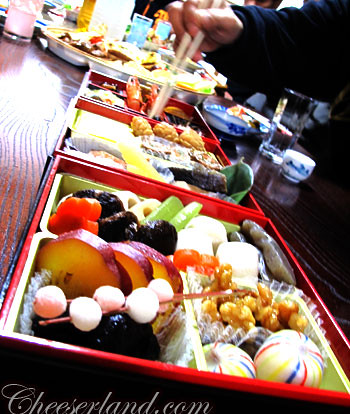
Wiki:
The Japanese celebrate New Year’s Day on January 1 each year. Before 1873, the date of the Japanese New Year) was based on the Chinese lunisolar calendar and celebrated at the beginning of spring. However, in 1873, five years after the Meiji Restoration, Japan adopted the Gregorian calendar, so the first day of January is the official New Year’s Day in modern Japan. It is considered by most Japanese to be one of the most important annual festivals.

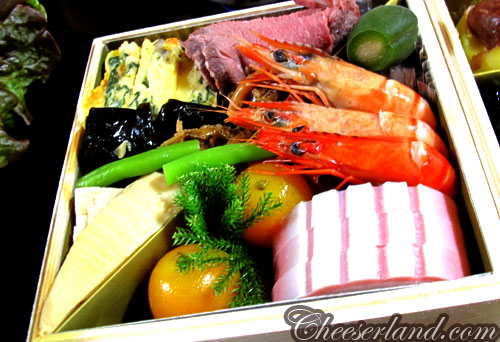
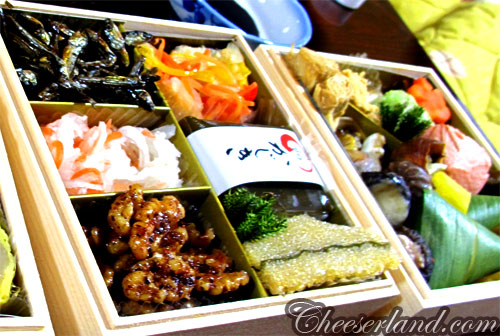
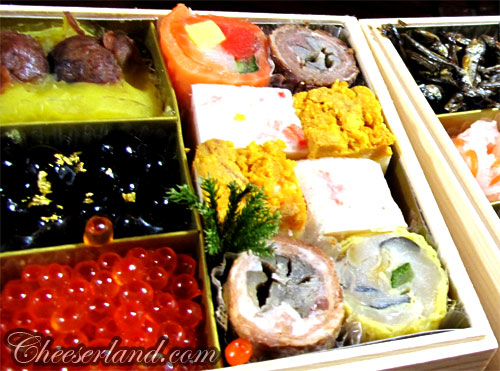
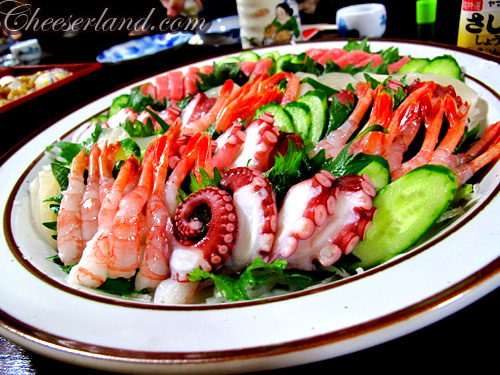


Some of the Osechi dishes have special meaning to it, just like Chinese New Year food. They also play a lot of food pun! 😀
For example,
- Daidai (橙), Japanese bitter orange. Daidai means “from generation to generation”.
- Kazunoko (数の子), herring roe. Kazu means “number” and ko means “child”. It symbolizes a wish to be gifted with numerous children in the New Year.
- Konbu (昆布), a kind of seaweed. It is associated with the word yorokobu, meaning “joy”.
- Kuro-mame (黒豆), black soybeans. Mame also means “health,” symbolizing a wish for health in the New Year. If you noticed in the picture they sprinkled gold on it!
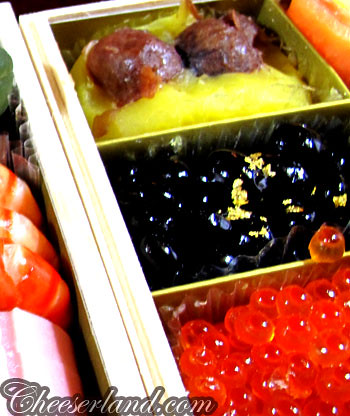
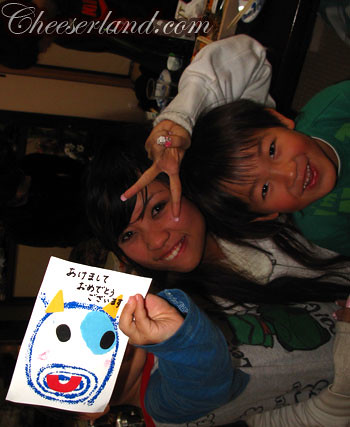
Happy Niu Year!
You wanna see more food? Or are you on a diet?










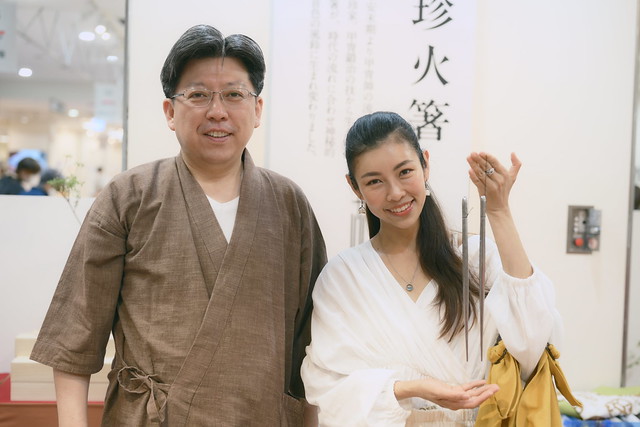
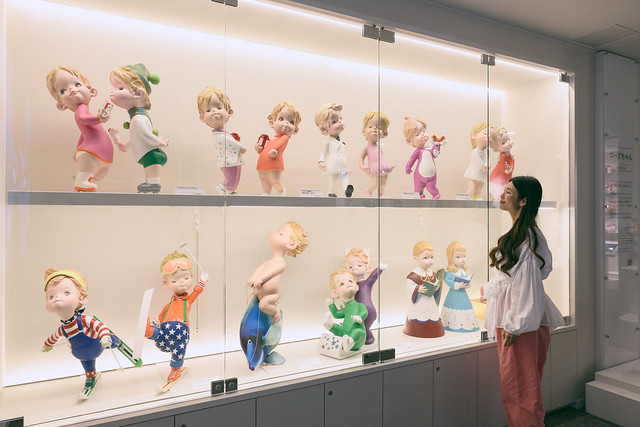



more food but still on diet
Screw the diet heehee 😀
GXFC Ms. Cheese!! <3
OMFG lifeless people like me commenting on CNY eve TT
KAZUNOKU! T_T so bigg.
Happy New Year Cheesie! You gonna be in KL?
Yee Hou: Me too la bro, nothing going on, so sad.
Don’t worry HB, YH. Me three!!!
haha
Least, you guys are not working eh?
the japanese new year food is very much different to chinese new year food eh…no pork,chicken or duck, i still prefer cny food…yum yum…
Ahhhh…FooooooD!!
Wonder how it tastes *Drooling*
Wow! COLORFUL Food! 🙂
Wanna see more food!
ah!! Ikura!!!!! So many of them!!!
Cheesy, Huai Bin and Yeehou
Happy Chinese New Year ar ;p
I am sure Huai Bin and Yee Hou know how to make urself busy right? ;p
FOOOOOOOOOOOOOOOOOD! Happy Chinese New Year.
Aww! So many food! It all looks so yummy! Suddenly I feel hungry. Kekeke…
And Cheesie, happy Chinese New Year!
hey ,those festive food looks very very colourful…… its make ppl feel like wanna plunged in to have it…. happy NIU year to you too gal….
I want to see some more food even though I’m on diet. 😀
Yeah, I’m crazy like that. 😀
Happy niu year!! =D
And more food please. =3
Wah, the one you had much more grand. Mine’s was the ‘free’ version by volunteers. Haha!
Those sure look delicious!~ You are making me hungry. Damn it!
Happy Chinese New Year!
Aww,I miss sushi. 🙁
niiiice.. luckily I’m full of abalone and whatnot already so it doesn’t make me get cravings 😛
i’m hungry T_____T
omg. my banner hahaha. so jakun what turf
The jubako boxes must cost a bomb, but they look delicious!
And Soba is meant to be for long prosperous life right (cz its so long and rarr)
Grr I want my Japanese life back … Happy New Year xoxo
Ps Japanese toilets are the bestest best! Out of all the things I miss about / of Japan … their toilets rank rather high. I just can spend so much time in there haha! But as much as I love it, I also feel guilty sometimes because you know those heated seats? They aren’t environmentally friendly, because electricity is needed to keep it warm of course and more electricity = less friendly.
I just really dont understand why people step on the seats in Malaysia’s toilets? Do they still do that? I’ve always hated that. Do you know why they do that? My friends want to go on holiday in Malaysia with me some time but im just dont know how to explain to them certain things lol.
Hunger!!!!!!!!!!!!!!!
jay: vicious cycle. it is too dirty to sit on it and the only way is to squat on it which makes it even dirtier so yea.
YH:what about lifeless ppl who blog on new years eve. *rolls eyes*
choco: eh i don’t think kazunoko is in the pix. Wait till u see the one i had in Osaka!!!!!!
HB: Back Sban d!!
tom: u leh. balik kampung liao la?
eee: ya but healthier!
hitomi: tasted awesome!
eevon: ya lo. damn shiok.
lynn: got alot more!
bluequeenjay: ikura daisuki
Tian Chad: same to you!
ST: happy ang moh new year!!
SiCuni: same to you!
breadpitt: but no bread
Michelle: ok deal.
kuroKEI: deal2
shana: wa you stay in jp?
Tommy: havent eaten reunion dinner meh?
YB: UK dont have meh
grace: wa damn shiok la your reunion. i only got prawn
natasha: why jakun!
Jeremy: that one i dunno la 😛
Happy CNY to you too! 🙂
Happy Moo Year to U too babe~! Meeet up meet uppppp!!! 😉
omg..moo..all the exotic food..
waaaah so many people still online and commenting on CNY lol… including me 😛 Just lazing around in seremban collecting ang pao’s leh, nothing much to do sien.. except to drool at ur pics that is.
can’t wait to go for fresh salmon sashimi and pomelo bits yee sang at Zen’s like i do every single year, orgasmic!!
Have,but very expensive. >_<
Oh gosh the food looks SO good! I hungry liao!
the roes are soo big… i’ve never seen such big.. these food makes me mouth watering…. yummylicious!
waliu….makes me super hungry…..